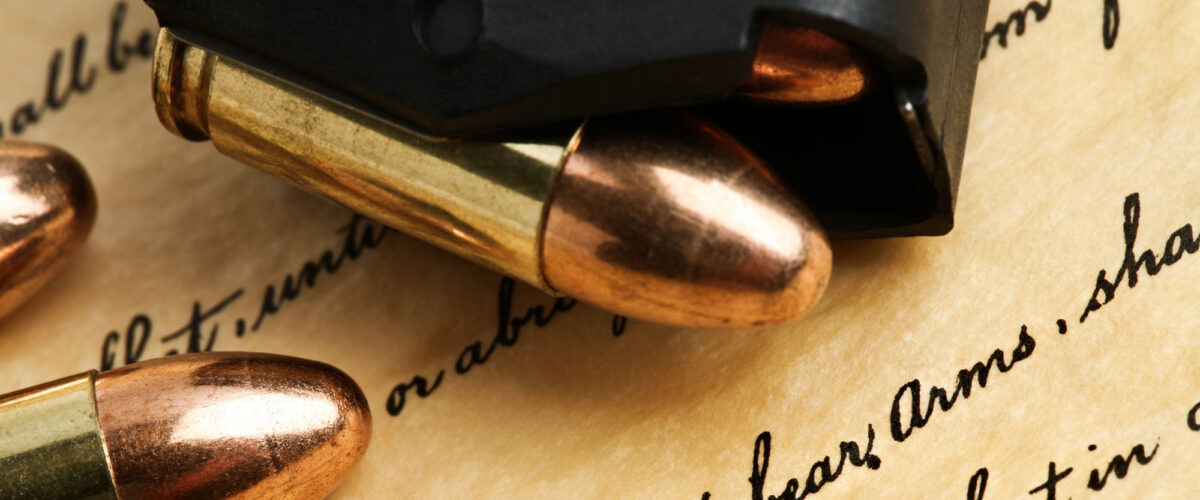A recent draft Supreme Court opinion suggests that a majority of the justices on today’s court may be willing to overturn even long-settled precedent, at least when they think they are reversing the creation of a spurious constitutional right out of thin air that was not intended by the framers of our Constitution, and where they further believe that this distortion of the Constitution has resulted in the deaths of innocent children. Strangely, I agree in principle, but I’m not talking about Roe v. Wade (my thoughts on that case can be found elsewhere).
I’m talking about United States v. Heller, the 2008 decision by which a 5-4 majority of the Supreme Court effectively rewrote the Second Amendment, creating a practically unfettered right of private gun ownership that cannot be squared with the plain text of the Second Amendment itself, nor with the debates surrounding that amendment’s adoption. I’m talking about a Heller decision that since has invalidated various state and federal attempts at gun control, stripping us of tools we need to address the rising tide of gun violence in America.
What the Second Amendment says
The language of the Second Amendment is sparse and a bit quirky, especially for modern readers. It simply provides: “A well regulated Militia being necessary to the security of a free State, the right of the people to keep and bear Arms shall not be infringed.”
“A well regulated Militia being necessary to the security of a free State, the right of the people to keep and bear Arms shall not be infringed.”
The public debates among the Founding Fathers surrounding the ratification of this amendment reveal that its sole purpose was to strip the federal government and its newly formed standing army of any right to disarm state militias, thus protecting individual state sovereignty. No mention whatsoever was made of any right of gun ownership separate and apart from state militia service. Instead, the right to “bear arms” was tied directly and exclusively to the continued viability of the various states’ militias.
That understanding of the Second Amendment would remain virtually unchanged for the next 200 years. For example, when Congress debated the merits of the federal government’s first major gun control legislation (the National Firearms Act of 1934) not a single mention was made of the Second Amendment in either the Senate or the House.
Even when a Second Amendment-based challenge to a portion of the act (regulating sawed-off shotguns) was brought five years later, the Supreme Court rejected it out of hand in United States v. Miller, holding in no uncertain terms that, as the “obvious purpose” of the Second Amendment was to “assure the continuation and render possible the effectiveness” of state militias, any purported right afforded by that amendment must “be interpreted and applied with that end in view.”
Thus, as there was no “rational relationship” between an individual’s purported right to own a sawed-off shotgun and militia readiness, the court upheld the National Firearms Act as constitutional, failing to even suggest a constitutional right of gun ownership separate and apart from state militia service.
Then came Heller
This understanding of the Second Amendment continued to be held by the Supreme Court and every federal circuit court to consider the question for more than 60 years. Then came Heller, when five justices (Scalia, Roberts, Kennedy, Thomas and Alito) ignored basic principles of statutory construction, the text of the amendment, evidence of its framers’ limited intent, and more than six decades of precedent to declare that individual Americans have a practically unlimited right of gun ownership wholly divorced from service in a state militia and struck down a statute limiting the possession of handguns in the District of Columbia.
Writing on behalf of the four dissenting justices, Justice Stevens stressed that — consistent with its plain language and its limited, militia-related purpose — the Second Amendment, properly read, does not “evidence the slightest interest in limiting any legislature’s authority to regulate private civilian uses of firearms.” While Justice Stevens was plainly correct, his voice of reason did not prevail.
In striking a serious blow against gun control, Heller has exacerbated our signature American obsession with guns. According to one 2018 study, while the U.S. then accounted for only 4% of the world’s population, it accounted for 46% of the world’s civilian-owned guns. Guns are not simply a golden calf that is inexplicably slavishly worshipped by many Americans. This particular golden calf is killing us and our children at an alarming, and increasing, rate.
Killing our children
The statistics are truly frightening. In 2000, twice as many children were killed in car accidents as were killed by guns in the U.S. By 2020 (due in part to safer cars, but also due in part to increased gun violence) guns had become the leading cause of death for Americans under the age of 20.
“By 2020 guns had become the leading cause of death for Americans under the age of 20.”
Particularly damning is a 2019 study conducted jointly by the University of San Francisco and Harvard which compared gun violence rates in the U.S. to those in other high-income nations. In short, the gun-related death rate in the U.S. was 11.4 times higher than in the dozen or so other nations studied.
Shockingly, 96.7% of all of the gun deaths suffered by children under the age of 4 during the period studied occurred in the U.S. While gun-related death rates had dropped in all the other studied nations since 2003, they had risen in the U.S. Of further note, the report suggested a relationship between the number of guns in a population and the rate of gun-related deaths, as the death rate in high-gun-ownership states was more than double the death rate in low-gun-ownership states.
Conversely, persuasive research shows that comprehensive national gun control legislation can decrease gun-related death rates and can practically eliminate mass shooting incidents such as the horror recently witnessed in Uvalde, Texas. Most notable are the lessons we can learn from Australia.
A lesson from Australia
In the immediate wake of a mass shooting at a grocery store in 1996, Australia adopted national gun control laws. As reflected in a particularly thorough 2021 Rand Corporation study, while these measures resulted in modest but statistically significant drops in overall gun-related suicide and homicide rates, so-called mass shootings (those involving four or more victims) essentially vanished overnight. More specifically, between 1981 and 1996, there were 190 victims of mass shootings in the U.S. and 97 such victims in Australia. From the date of Australia’s enactment of national gun control measures in 1996 until 2013, there were 386 victims of mass shootings in the U.S. and none in Australia. Zero.
“Simply put, gun control works and saves lives.”
Simply put, gun control works and saves lives. Conversely, a lack of such measures is deadly, especially for children. According to one CNN compilation, 288 school shootings occurred in the U.S. between 2009 and 2018. Mexico was the nation with the second highest number of school shootings in that same period, with a grand total of eight.
Given the evidence, one would expect that someone who considers himself or herself to be “pro-life” would be a strong supporter of gun control. That has not been the experience of white evangelicals in the U.S. A study of gun control attitudes in the wake of the Aurora, Colo., theater mass shooting in 2012 found that gun ownership rates were much higher among white evangelicals (58%) than among Catholics (32%) or the U.S. population as a whole (36%). This same study reflected that — while 62% of Catholics and 60% of all Americans favored stricter gun control measures — only 35% of white evangelicals agreed.
As recently stated by Cardinal Blase J. Cupich, archbishop of Chicago: “The Second Amendment did not come down from Sinai. The right to bear arms will never be more important than human life.”
“The Second Amendment did not come down from Sinai.”
Amen. My fervent prayer is that my fellow white evangelicals will repent of their idolatrous obsession with guns, that they will come to love their neighbors more than the Second Amendment, and that they will finally live into their self-proclaimed appellation by choosing life instead of death, and by supporting the nomination of judges and justices with a principled openness to reasonable gun control measures rather than a distorted, politically fueled view of the Second Amendment.
Maybe then our children can quit paying for our idolatry with their lives.

Chris Conley
Chris Conley is an attorney and graduate of the University of Georgia and of the Emory University School of Law. He and his wife, Mary, live in Athens, Ga., where both are members and deacons at First Baptist Church. They have one son, Aaron, who also is an attorney, and a miniature schnauzer, Oso, whose career path remains uncertain.
Related articles:
After Uvalde, let us dream of impossible things | Opinion by Andrew Manis
‘And deliver us from evil’ motivates some gun owners
In the war of words over guns, ‘wisdom is better than weapons of war’ | Opinion by Russell Waldrop


